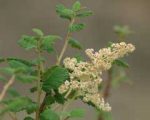 Rock spirea is a deciduous shrub also known as mountain spray, rock spirea, bush oceanspray, and glandular oceanspray, and is a member of the rose family, Roseaceae, that also includes cherry, almond, and lady’s mantle. It is native to western North America from Oregon to Wyoming, South to far west Texas and northern Mexico where it grows in woodland, shrubland, cliffs, canyons and dry slopes. The sprawling plants can grow up to 20′ tall and have intricately branched stems with exfoliating bark when mature, and reddish twigs that may be slightly spiny. The ovate, lobed or coarsely toothed leaves are slightly less than 1″ long, and have pronounced veins. They have a spicy scent when crushed and turn orange in the fall. In summer, small pinkish-white to cream colored flowers appear in feathery 2-8″ long panicles and have about 10 petals and numerous conspicuous stamens. The flowers turn attractive orange when dry and have very small 1 seeded dry fruits. Plants are attractive in shrub borders and rock gardens. The genus name, Holodiscus, comes from the Greek words holos meaning entire, and diskos meaning disc, and refers to the unlobed structure that holds the flower parts. The specific epithet, dumosus, is the Latin word for bushy or shrubby and refers to the grow habit of the plant.
Rock spirea is a deciduous shrub also known as mountain spray, rock spirea, bush oceanspray, and glandular oceanspray, and is a member of the rose family, Roseaceae, that also includes cherry, almond, and lady’s mantle. It is native to western North America from Oregon to Wyoming, South to far west Texas and northern Mexico where it grows in woodland, shrubland, cliffs, canyons and dry slopes. The sprawling plants can grow up to 20′ tall and have intricately branched stems with exfoliating bark when mature, and reddish twigs that may be slightly spiny. The ovate, lobed or coarsely toothed leaves are slightly less than 1″ long, and have pronounced veins. They have a spicy scent when crushed and turn orange in the fall. In summer, small pinkish-white to cream colored flowers appear in feathery 2-8″ long panicles and have about 10 petals and numerous conspicuous stamens. The flowers turn attractive orange when dry and have very small 1 seeded dry fruits. Plants are attractive in shrub borders and rock gardens. The genus name, Holodiscus, comes from the Greek words holos meaning entire, and diskos meaning disc, and refers to the unlobed structure that holds the flower parts. The specific epithet, dumosus, is the Latin word for bushy or shrubby and refers to the grow habit of the plant.
Type: Flowering deciduous shrub
Outstanding Feature: Flowers
Form: Sprawling
Growth Rate: Moderate
Bloom: Three to eight inch long clusters of pinkish white to creamy white flowers in summer
Size: 1.6 -20′ H x 5-10′ W
Light: Full sun
Soil: Average, dry, well-drained
Hardiness: Zones
Care: Prune after flowering when desired.
Pests and Diseases: None of significance
Propagation: Seed, layering, cuttings
Photo Credit:Wikipedia Commons